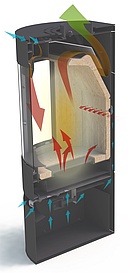How to choose your new stove?
There are countless wood burning stoves on the market, and the easiest thing is to let taste and preference decide on a stove. However, it is important to think more carefully before investing in a new wood burning stove, as you will have the stove for many years.
Besides having heating area, location of the stove and distance to combustible materials in mind, you should also decide on more general things such as stove type, size, operating options, air supply, and chimney draft.
Below we have collected relevant information that can be decisive when choosing your new wood burning stove.
Convection heat or radiant heat?
There are 2 different kinds of stoves: convection stoves and radiant stoves. With radiant stoves, the heat is concentrated around the stove. The stove emits a strong heat to the area around the stove and the further away from the stove you get, the colder it gets. Convection stoves on the other hand distribute the heat by circulating air around the room. This gives a pleasant and homogeneous heat in the room. Compared to radiant stoves, convection stoves can typically be placed closer to flammable materials due to the relatively low surface temperature. This also makes it more child-proof. All wood burning stoves from Aduro are convection stoves.
Does a small or large stove match your needs?
It is important to find the right size of the stove, so that you can get the optimal effect from it. The size depends among other things on the insulation and size of the house, the furnishing, and where the stove will be situated. Do not buy the stove too big. Most people will tend to fire too little and with too low a temperature, so the heat won’t be very strong. This creates bad combustion.
The stoves nominal effect is stated in kilowatt (kW). As a rule of thumb, 1 kW can warm up 10 square meters if the house is poorly insulated. If the house has good insulation, 1 kW can warm up 20 square meters.
In most cases, all wood burning stoves from Aduro suit your heating demand, because the heat output typically can be regulated from 3-4 to 8-9 kW. Only in the following two cases should you pay attention to the size of the stove:
- If your heating demand is less than 3 kW, you should choose a stove with a nominal output of maximum 5 kW.
- If your heating demand is more than 7 kW, you should choose a stove with a nominal output of at least 6 kW.
If you are in doubt about the size of the stove, we recommend contacting your local chimney sweep or dealer.
Side glass, or not?
A wood burning stove with side glass gives a greater view of the flames, as they can be enjoyed from several sides and not just from the front. However, it is important to keep the location of the stove in mind when buying a new stove, as this has an impact on whether you should choose a stove with or without side glass.
A wood burning stove with side glass must be placed further from combustible material than a wood burning stove without side glass. Therefore, a stove without side glass is ideal for placing in a corner.
How “tight” is your house?

All wood burning stoves need constant supply of air to ensure optimum combustion. This is often a problem in modern energy-efficient houses that are very tight. Therefore, some Aduro stoves are equipped with external supply of combustion air, where the air to the combustion is supplied from the outside and directly into the wood burning stove. Look for the AIR icon, which is shown here to the right, among our stoves, if you are looking for a stove with the possibility of externa air supply.
New wood burning stove with an old chimney
To benefit from your wood burning stove, you must ensure that your chimney is fully functional and in good condition. The chimney is the motor of the stove, and therefore, it is crucial to the efficiency of your wood burning stove. If you need to keep the primary air damper open to keep the stove going, it is a sign that the chimney is not working properly.
New wood burning stoves are designed differently than old stoves. New stoves are built with more resistance, and therefore, much less heat is sent out through the chimney. This “colder” smoke temperature entails less draft in the chimney since the draft is created through the temperature differences between the air outside and the smoke inside the chimney. If your chimney does not function, you may experience smoke return, smoke in the room, and a bad combustion. In that case, we recommend mounting the smoke exhauster Aduro DraftOptimizer, which ensures a stable operation. Learn more about Aduro DraftOptimizer here.
Choose a stove with easy operation
Sufficient air supply is alpha and omega
Aduro wood burning stoves are equipped with different dampers, which regulates the combustion air: primary, secondary, and tertiary air supply. The primary air is used at the beginning to get the fire going, whereas the secondary air keeps the fire burning evenly. The secondary air also regulates the efficiency. The tertiary air on the other hand ensures that flue gasses are burned. This is regulated automatically. The illustration on the right shows the primary-, secondary-, and tertiary air supply.
Automatically regulation of the primary air damper
If you are looking for a wood burning stove that is easy to operate, an Aduro stove with Aduro-tronic automation is the answer. Aduro-tronic automatically regulates the primary air in your wood burning stove after one simple pull and works without electricity. All Aduro wood burning stoves are equipped with Aduro-tronic as a standard. Learn more about Aduro-tronic here.
Air-wash system
To ensure an unobstructed view of the fire, all wood burning stoves from Aduro are equipped with an effective air-wash system that prevents soot on the glass. The air-wash system consists of heated air which is ducted to wash over the inside of the glass, preventing the glass from sooting.

 Dansk
Dansk Deutsch
Deutsch English
English Français
Français Dutch
Dutch Norsk
Norsk Suomi
Suomi Svenska
Svenska Español
Español Italiano
Italiano
